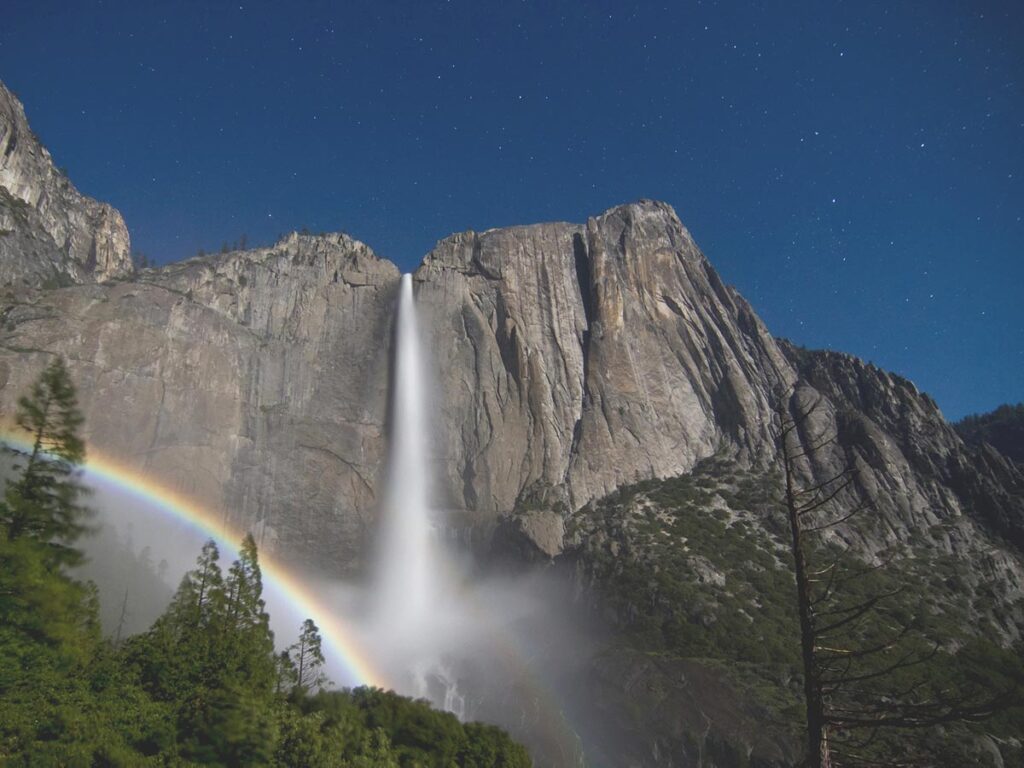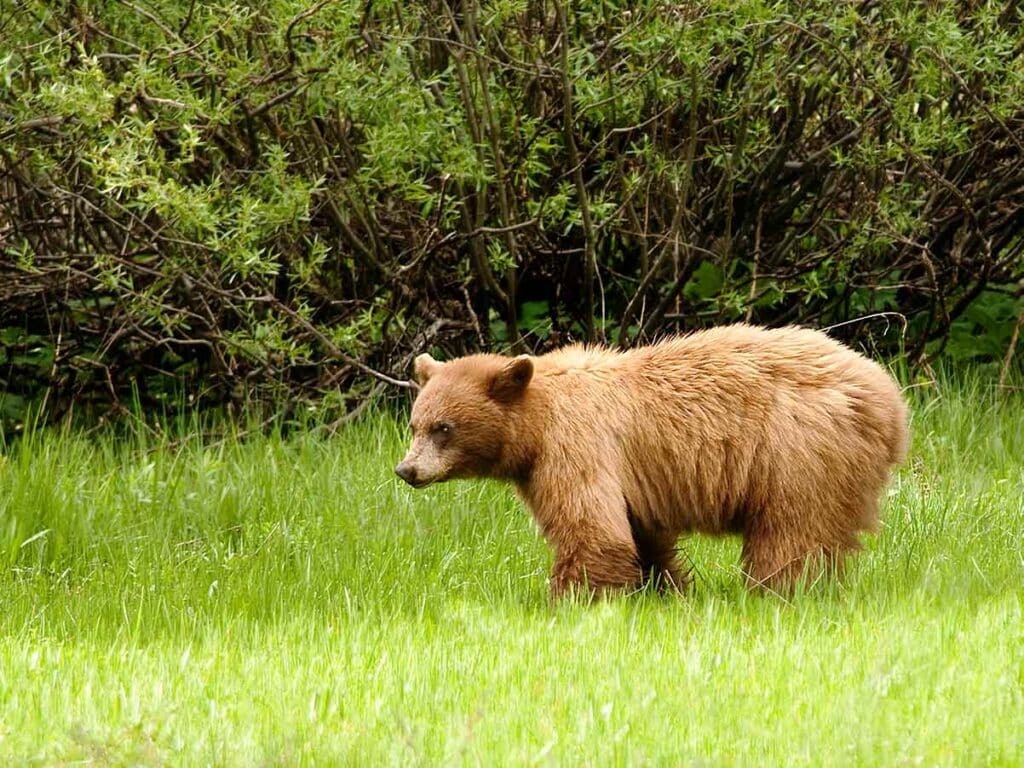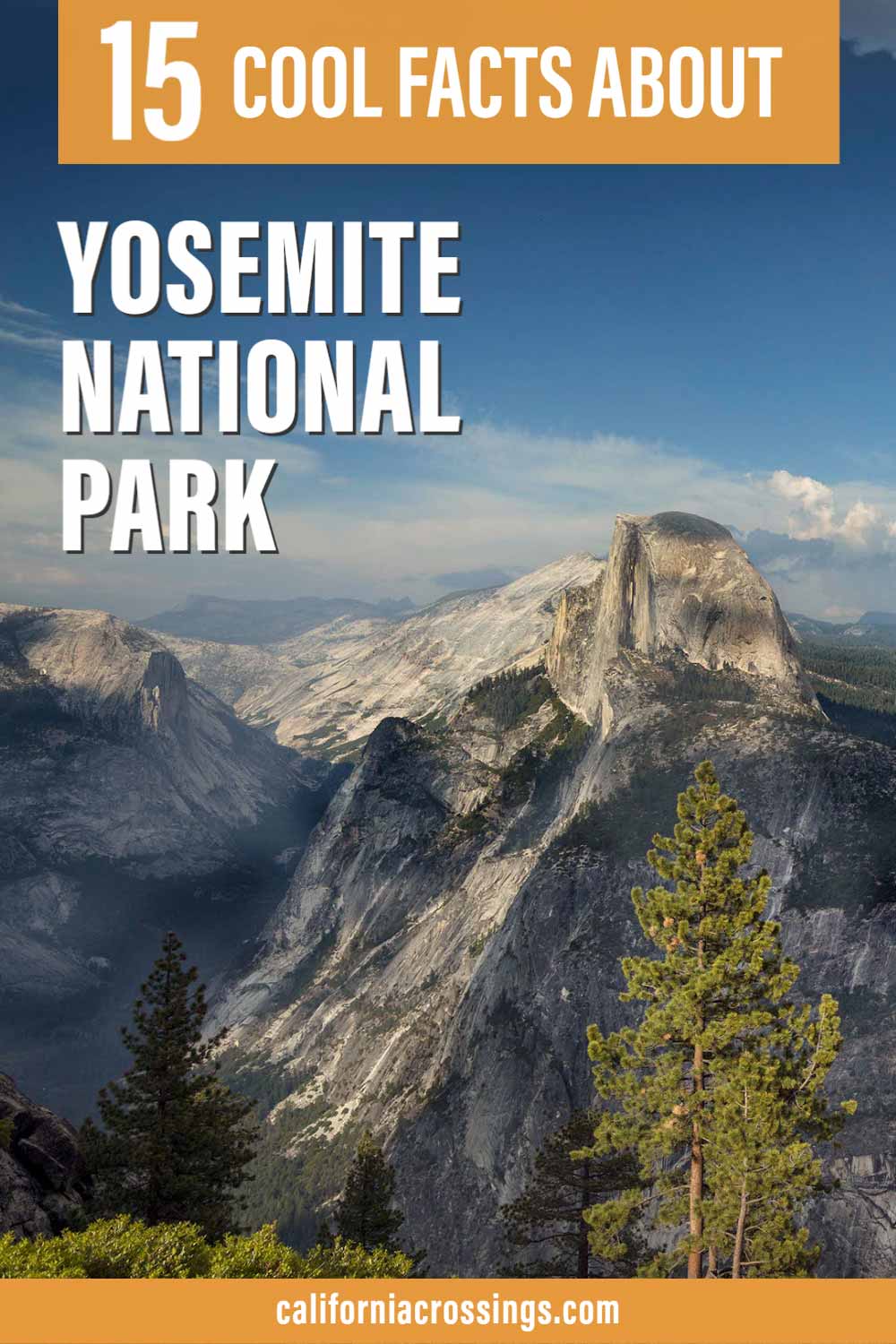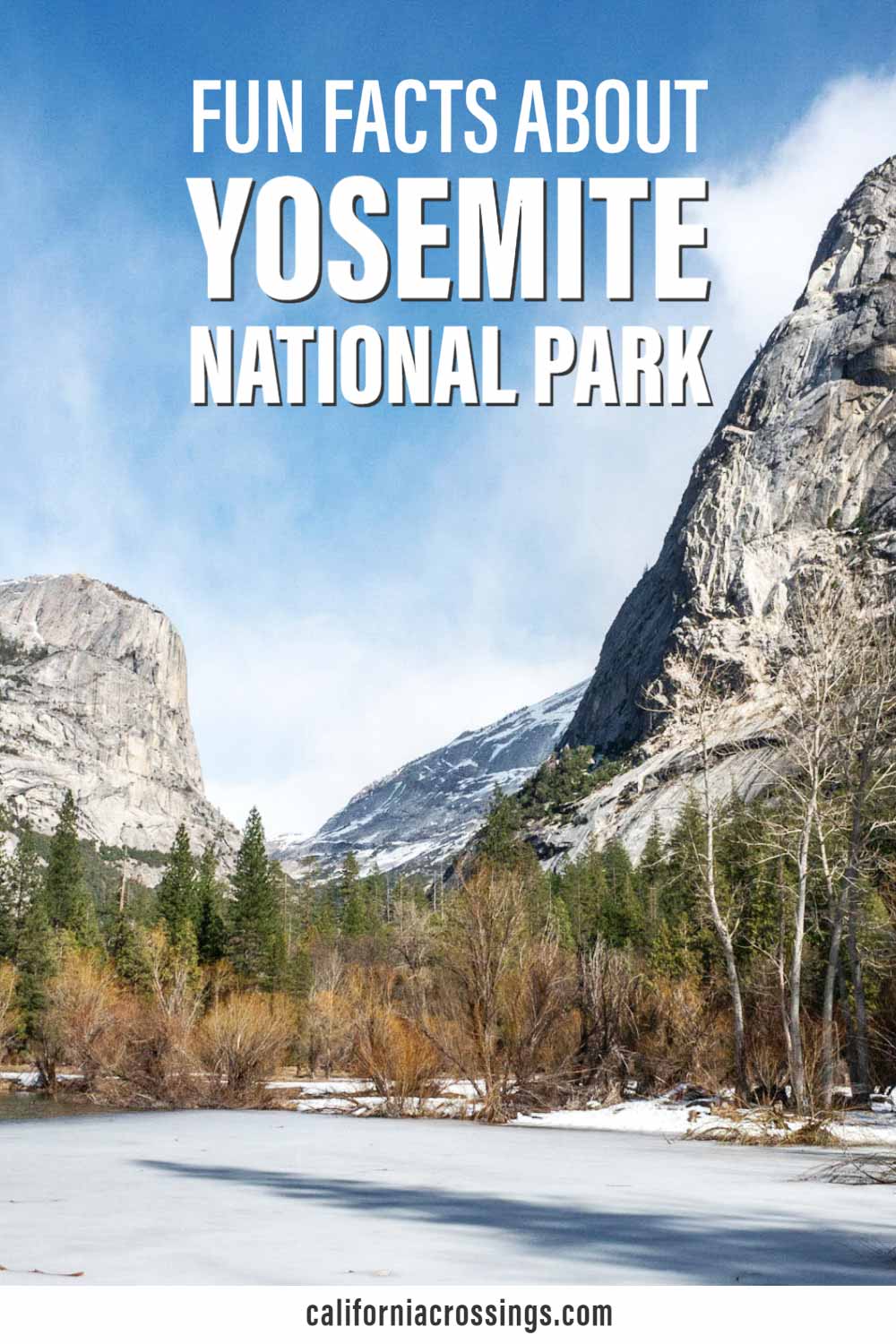Know before you go by checking out these 15 cool Yosemite National Park facts. Find out what makes the park the oldest, tallest, largest and most spectacular of our National Parks. Learn about how a slumber party between John Muir and Teddy Roosevelt shaped our national park landscape and why Yosemite is called the “big mouth” of California.
These fun facts about Yosemite National Park will fill your brain with information about the park’s history, geology, animals, and how it’s been affected by visitation.

(This article contains affiliate links. This means that if you choose to purchase, I’ll make a small commission.)
After loading up on all of our Yosemite National Park facts, plan your next trip there using our resources:
- 25 fun things to do in Yosemite in the winter. This list gives advice on what’s open in the winter, the iconic firefall event, hiking suggestions and lodging ideas.
- Take the slow road getting there with this SF to Yosemite road trip. It includes top stops in the park along with some additional sites to see in Gold Country on the way there and back.
- Figure out what to pack for Yosemite…whatever the weather.
- The closest and most convenient airports near Yosemite.

15 Fun Facts About Yosemite National Park
This Yosemite trivia won’t tell you everything about the park, but it will give you some interesting factoids that will inform your trip…and amaze your friends during pub trivia night. So, let’s dive in.
1. Yosemite Is One of Our Most Popular Parks
Yosemite National Park receives ~4.5 million visitors a year, making it our 5th most popular National Park after Great Smokey Mountains, Grand Canyon, Rocky Mountain and Zion.
2. Yosemite is 94% Wilderness
Fun fact about Yosemite National Park…if you are willing to get out of of the valley, you can have the wilderness to yourself. While the Yosemite Valley is only 7 miles long, the whole park is 1,187 square miles (or about the size of Rhode Island).
Yosemite has 214 miles of road but 800 miles of hiking trails, and the back country makes up 94% of the park.
Most people visit only the Yosemite Valley…and even then, many for only a day. So, if you are willing to expand your trip outside of the valley, you can have trails, granite peaks and Giant Sequoia groves all to yourself.
3. Yosemite Wasn’t Our First National Park…But It Kinda Was
Yellowstone was the first National Park. It was established in 1872 when President Grant signed the Yellowstone National Park Protection Act.
But.
In 1864, President Lincoln signed the Yosemite Grant, which entrusted Yosemite Valley and the Mariposa Grove to the care of California. Its purpose was to preserve the land for recreation– the first protection of its kind, not only in the US, but arguably anywhere. This made Yosemite our first defacto National Park and its preservation inspired our National Park system. Yosemite later officially became a National Park in 1890.

4. Yosemite Valley is “The Place of the Big Mouth”
The Anglicized name “Yosemite” is derived from “ho’hem-itch”, a Miwok word for the Native Americans who lived in the area. But they called the valley “Awooni” (later Anglicized to “Awhanee”. It means “The Place of the Big Mouth” or “Gaping Mouth Place”.
And if you’ve ever visited the Yosemite Valley, you’ll certainly see that the descriptor is apt, what with the narrow opening, and steep cliffs that hem in the valley.
If you are keen to learn more about the Miwok people, stop into the Wassama Round House State Park, which is near Mariposa and an easy stop on the way into the valley.
5. Native American Habitation Goes Back 3,400 Years
There is evidence of human habitation in Yosemite going back to 1,400 BC.
6. John Muir Loved Yosemite Deeply
There is no single individual who did more to spark our vast national park system than John Muir. He was a leader in conservation, a wilderness enthusiast and a very influential writer and lobbyist. When Muir washed up in California in 1868, he asked a local how to get out of town and see “any place that is wild”. They pointed him east to Yosemite Valley.
So he walked there. All the way to Yosemite. From San Francisco.
This fortitude is what allowed him to survive his many forays into the wilderness of the Sierra Nevada mountains. And he often setting out with just a blanket, a hunk of bread and some tea. He fell in love with Yosemite and he took whatever random jobs he could find in order to stay there.
You can learn more about Muir’s life by visiting his home and farm in the Bay Area.
7. And He Made Teddy Roosevelt Love It Too
Some serious magic happened in 1903, when Muir invited Teddy Roosevelt to visit Yosemite. Muir and Roosevelt ditched the security detail and went camping alone in the woods. And that sealed the deal for our National Park System.
Roosevelt was so impressed by Yosemite, that he was inspired to to grant a whole bunch of new national parks, including an expansion of Yosemite. During his presidency, Roosevelt designated 5 national parks, 18 national monuments, 55 bird sanctuaries and wildlife refuges, and 150 national forests.
Thanks John, and way to go Ted!
No temple made with hands can compare with Yosemite”
-John Muir (find more quotes from John Muir.)
8. El Capitan Is One Huge Rock
El Capitan looms over Yosemite Valley. It’s the world’s largest monolith, rising 3,593 feet from the valley floor. El Capitan is popular with climbers, but getting up the face takes a lot of chutzpah. You can get a sense of just how hairy it is by perusing some of the climbing route names such as: Never Never Land, Wet Denim Daydream, Flight of the Albatross, Jesus Built my Hotrod, Eagle’s Way, Scorched Earth and Skull Queen.
9. Yosemite Falls is One Huge Waterfall
Not to be outdone, the 2,425 foot Yosemite Falls also holds the record as the tallest waterfall in North America and one of only four on the continent that exceed 1,000 feet.
10. The Sierra Nevada Mountains Are One Huge Mountain Range
Not to overload you with yet more interesting facts about Yosemite’s hugeness, but the Sierra Nevada range, which houses the park, is the longest and highest continuous mountain range in America. The range is 470 miles long and covers ~20% of California’s land mass. The highest peaks within Yosemite top out at 13,000 feet.
The range began pushing up about 25 million years ago and was carved by glaciers.

11. The Giant Sequoia Redwoods Are Some Really Huge Trees
But wait- we aren’t done with Yosemite’s huge facts quite yet.
Not to be outdone by the geology, the Giant Sequoia redwood trees in Yosemite (and nearby Kings Canyon and Sequoia National Park) are the largest trees in the world (by density). They are just one of three giant redwoods. The other two include the coast redwoods in northern coastal California, and a species in China.
The Giant Sequoia can grow to 40 feet in diameter and 300 feet tall over their 3,000 year lifespan. For perspective, these trees are roughly the size of the Statue of Liberty.
You can visit these giants in Yosemite at the Mariposa, Merced and Tuolumne groves.
12. Hiking Half Dome is Not for the Faint-Hearted
In 1875, Scotsman George Anderson became the first person to successfully climb Half Dome. He rigged up his own version of a rope ladder, which was the predecessor to today’s steel cables. These cables are pounded into the bare rock and cover the last 400 feet of the climb.
Hiking Half Dome today requires you to luck out on one of the 300 daily permits, and it demands the wherewithal to hike 16 miles and 5,000 vertical feet in a day.

13, Yosemite National Park Houses 77 Kinds of Mammals
You will find charismatic predators like the black bear, coyote and mountain lion in Yosemite. But the park is also home to some tamer species like big horn sheep, ground squirrels, and mule deer.
14. Yosemite National Park Houses some 11 Endangered or Threatened Species
Yosemite’s higher reaches house the very rare Sierra Nevada Bighorn Sheep. It’s thought that there are only about 30 members in this rare herd. There are also 10 other threatened or endangered animals such as: mountain yellow-legged from, Yosemite toad, great gray owl, willow flycatcher, Sierra Nevada red fox, peregrine falcon and the southern bald eagle.

15. Yosemite’s Annual Firefall is a Visual Spectacular.
Time was, that the park would create a spectacle by lighting a fire at top of Glacier Point and then pushing it over the edge, creating flaming waterfall effect. They stopped doing that in the 1970’s, as there are unfortunately plenty of natural fires in the park for the rangers to keep an eye on.
However, in February the sunset lines up just right with Horsetail Falls, creating a visual firefall as the sun reflects off the cliff face. It’s quite a spectacle and accessible to anyone willing to show up early and brave the cold weather.
Some People Just Don’t Get Yosemite
Complaints about how busy Yosemite is during the summer are certainly valid. But some people who visit our National Parks simply don’t get the big picture. In her delightful book Sub Par Parks, Amber Heard has paired tone-deaf negative National Park reviews with lovely illustrations that belie the complaint.
“Trees block the view…and there are too many gray rocks”, opined one complainer, who apparently couldn’t tolerate Yosemite’s towering granite cliffs and fragrant pine forests.
If you love our parks, you should definitely buy her book (and it makes a great gift too).

Get More Fun Facts
If you’ve enjoyed these fun facts about Yosemite, then you may also enjoy our series featuring trivia about Lake Tahoe, Death Valley National Park, Joshua Tree National, SF’s cable cars and the Golden Gate Bridge.
Explore More of California’s National Parks
Start with our full guide for ALL California National Parks. It offers a brief description of each (with highlights) and a map. Then check out some of our park-specific guides.
- Death Valley visitor’s guide.
- Joshua Tree visitor’s guide.
- San Francisco’s Presidio.
- North Coast Redwoods road trip (incl. Redwoods National Park).
Share these cool Yosemite National Park facts with your friends:


